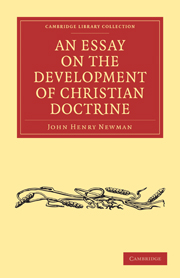Book contents
- Frontmatter
- ADVERTISEMENT
- Contents
- INTRODUCTION
- CHAPTER I ON THE DEVELOPMENT OF IDEAS
- CHAPTER II ON THE DEVELOPMENT OF CHRISTIAN IDEAS, ANTECEDENTLY CONSIDERED
- CHAPTER 3 ON THE NATURE OF THE ARGUMENT IN BEHALF OF THE EXISTING DEVELOPMENTS OF CHRISTIANITY
- CHAPTER IV ILLUSTRATIONS OF THE ARGUMENT IN BEHALF OF THE EXISTING DEVELOPMENTS OF CHRISTIANITY
- CHAPTER V ILLUSTRATIONS CONTINUED
- CHAPTER VI ILLUSTRATIONS CONTINUED
- CHAPTER VII ILLUSTRATIONS CONTINUED
- CHAPTER VIII ILLUSTRATIONS CONCLUDED
CHAPTER VIII - ILLUSTRATIONS CONCLUDED
Published online by Cambridge University Press: 16 May 2011
- Frontmatter
- ADVERTISEMENT
- Contents
- INTRODUCTION
- CHAPTER I ON THE DEVELOPMENT OF IDEAS
- CHAPTER II ON THE DEVELOPMENT OF CHRISTIAN IDEAS, ANTECEDENTLY CONSIDERED
- CHAPTER 3 ON THE NATURE OF THE ARGUMENT IN BEHALF OF THE EXISTING DEVELOPMENTS OF CHRISTIANITY
- CHAPTER IV ILLUSTRATIONS OF THE ARGUMENT IN BEHALF OF THE EXISTING DEVELOPMENTS OF CHRISTIANITY
- CHAPTER V ILLUSTRATIONS CONTINUED
- CHAPTER VI ILLUSTRATIONS CONTINUED
- CHAPTER VII ILLUSTRATIONS CONTINUED
- CHAPTER VIII ILLUSTRATIONS CONCLUDED
Summary
APPLICATION OF THE FIFTH TEST OF FIDELITY IN DEVELOPMENT.
Logical Sequence was set down in the first Chapter of this Essay as a fifth test of fidelity in development, and shall now be briefly illustrated in the history of Christian doctrine. That is, I mean to give instances of one doctrine leading to another; so that, if the former be admitted, the latter can hardly be denied, and the latter can hardly be called a corruption without reflecting on the former And I use “logical sequence,” in contrast to that process of incorporation and assimilation which has lately been under review, to denote an internal growth of doctrine and usage in the way of reasoning. Accordingly it will include any progress of the mind from one judgment to another, as, for instance, by way of moral fitness, which may not admit of analysis into premiss and conclusion. Thus St. Peter argued in the case of Cornelius and his friends, “Can any man forbid water that these should not be baptized, which have received the Holy Ghost as well as we?”
Developments growing out of the Question of our Lord's Divinity.
No one who has looked ever so little into the theological works of the ancient Church, but is aware that the language of the Ante-nicene Fathers, on the subject of our Lord's Divinity, may be far more easily accomodated to the Arian hypothesis than the language of the Post-nicene.
- Type
- Chapter
- Information
- An Essay on the Development of Christian Doctrine , pp. 397 - 453Publisher: Cambridge University PressPrint publication year: 2010First published in: 1845



